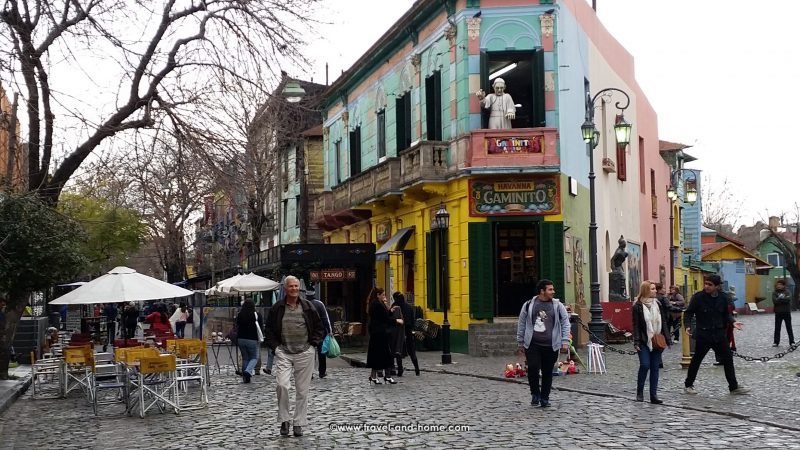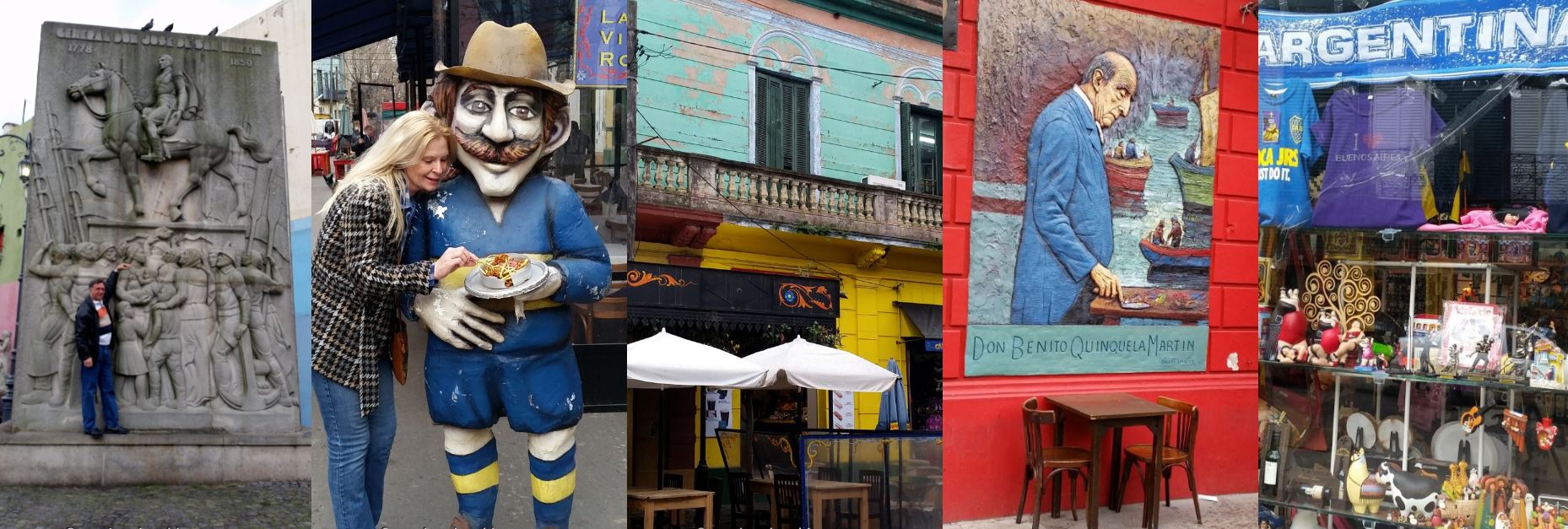Home » Travel Destinations » This Is Why You Should Go To Caminito Open Air Museum In Buenos Aires
Caminito Street is a treasure trove of history, art, and cultural significance that has made it a must-visit spot in Buenos Aires. Let’s dive deeper into the vibrant tapestry of this iconic destination.
It’s an “open-air” Street Museum and a traditional alley located in La Boca. This Buenos Aires neighborhood is famous for its colorful houses, its tango, and its soccer team.
Caminito” (Spanish for “little walkway” or “little path”) was named after a 1926 tango song composed by Juan de Dios Filiberto, which tells of a love lost.

In the 1800s there was a small stream flowing into the Riachuelo River. After the river dried up, tracks for the Ferrocarril Buenos Aires y Puerto de la Ensenada were installed at the site. Along Garibaldi Street, you can still see the disused tracks. Later, when the railway route in La Boca closed (1954), the area fell into neglect. Inspired by the tango song, Benito Quinquela Martín (an Argentine painter) and his friends decided to breathe new life into this forgotten space (around 1955) by adding color and later (1960) a theatre stage.
The transformation began when the artists used leftover paint from the nearby shipyards to splash color onto the buildings. These structures, initially abandoned, became canvases for their creativity. The result? A kaleidoscope of hues lining the cobblestone streets, each building telling a story through its vibrant façade.
In Argentina, they use the Peso as their currency, which is symbolized by the dollar sign ($). Spanish is the main language spoken there. Oh, and if you’re planning your schedule, remember they follow the UTC−3 time zone. When you hit the road, keep in mind they drive on the right side. As for visas, many countries get a sweet deal—a 90-day free pass to explore all the wonders Argentina has to offer!

Caminito isn’t just about colors; it’s a microcosm of Argentine culture. Tango, the passionate dance synonymous with Argentina, was born in these streets. As you stroll along, you might catch impromptu tango performances. The rhythmic beats, the intricate footwork—there’s an electric energy that fills the air.
In Argentina, Spanish is the primary language spoken. While many people in touristy areas and certain industries might know some English, especially in hotels, restaurants, and shops, the overall English proficiency might vary outside those areas. It’s always a good idea to have some basic Spanish phrases handy, just in case!
Like, in Spanish, you would say “¿Hablas inglés?” ( pronounced: AH-blahs een-GLEHS?) to ask someone if they speak English.
Suggested Read: Here’s a pocket guide of handy English-to-Spanish translations for your trip to Argentina.
The street itself, just 100 meters long, is packed with visual delights. You’ll encounter artists selling their creations—handcrafted goods, paintings, and souvenirs that showcase the local craftsmanship. Art galleries dot the area, displaying the works of emerging and established Argentine artists, offering a glimpse into the contemporary art scene.
Beyond Caminito, La Boca pulses with life. The neighborhood, historically inhabited by Italian immigrants, boasts a unique blend of cultures. Wander through its streets to witness the fusion of Italian and Argentine influences, from the aroma of homemade pasta to the sounds of passionate debates over a game of football.
This is in my luggage. Leak-proof sleeves for my toiletries to prevent spills. My Remington is non-negotiable for the perfect hairstyle come dinner time. And then I’m ready to slip into my silk satin tank top which I can mix and match as I wish! – Michelle Joubert

Paid Link: As an Amazon Associate we earn from qualifying purchases.

The Proa Foundation, an avant-garde art space, is just a stone’s throw away. It hosts exhibitions featuring both local and international artists, providing a deeper insight into modern artistic expressions. Then there’s the Quinquela Martín Museum, dedicated to the artist whose vision played a pivotal role in Caminito’s transformation.
Address: Av. Pedro de Mendoza 1929 y Caminito, La Boca, Buenos Aires.
We stayed at the Cyan Recoleta Hotel. It’s right across from Cementerio de la Recoleta, where Evita Peron’s grave is. This spot turned out to be perfect for us because it’s smack in the middle of all the sightseeing action, plenty of restaurants, and the buzzing nightlife. Great call on the location!
Scan for seasonal deals before booking your stay.
If you have a bar fridge in your hotel room, check with reception whether the content is on the house, or pay as you use.
Buenos Aires, often called the “Paris of South America,” is a city brimming with character. Beyond Caminito, delve into its rich history by visiting the historic neighborhoods of San Telmo and Recoleta. Feast on delicious Argentine cuisine—succulent steaks, empanadas, and dulce de leche desserts are a must-try!
The weather in Buenos Aires is generally mild. Summers (December to February) can get hot and humid, while winters (June to August) are cooler. Spring (September to November) and fall (March to May) offer pleasant temperatures, making them ideal for exploring the city.
Caminito Street is not just a picturesque spot; it’s a living canvas that encapsulates the essence of Argentine culture. From its humble origins to its vibrant present, it’s a testament to the transformative power of art and community. So, as you embark on your journey to Buenos Aires, prepare to immerse yourself in a world of colors, rhythm, and stories waiting to be discovered around every corner.
Planning a trip revolves around key elements like flights, accommodation, activities, and cuisine. They form the foundation of a successful travel experience. It’s like building a well-rounded story, and these pillars indeed play a crucial role.
Reviews from our readers….
Share or Save !
Explore exclusive deals from our trusted partners: Aviasales for budget-friendly options, CheapOAir for great discounts, CheapTickets for diverse choices, and Travelstart for hassle-free bookings. Experience luxury with Qatar Airways, Swiss International, Austrian Airlines, and Lufthansa. Seeking adventure? Fly with the style of Iberia or the iconic Virgin Atlantic. Treat yourself and fly with Ethiopian Airlines awarded by World Travel Awards as Africa’s Leading Airline in 2020, 2021 (in Economy Class), and 2023. Your journey starts here – click the links that suit your travel dreams.
Travel and Home uses affiliate links at no extra cost to you. Our disclaimer information includes “Advertiser Disclosure”, for example, Amazon.
Copyright ©2023 TRAVEL AND HOME® All Rights Reserved.| Disclaimer | Privacy & Cookie Policy | About Us